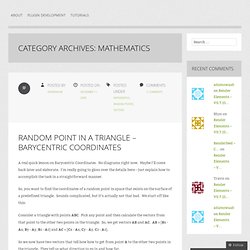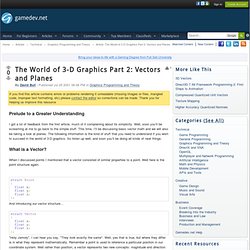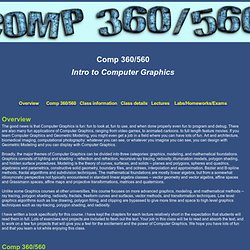

Technical Repository. A real quick lesson on Barycentric Coordinates.

No diagrams right now. Maybe I’ll come back later and elaborate. I’m really going to gloss over the details here – just explain how to accomplish the task in a straightforward manner. So, you want to find the coordinates of a random point in space that exists on the surface of a predefined triangle. Sounds complicated, but it’s actually not that bad. Consider a triangle with points ABC. So we now have two vectors that tell how how to get from point A to the other two points in the triangle. So, what if we start at point A, go a random percentage along the AB vector, then go another random percentage along the AC vector? Barycentric coordinates are three numbers that add up to one. Consider a unit triangle in two dimensions.
Technical Repository. An Interactive Guide To The Fourier Transform. The Fourier Transform is one of deepest insights ever made.

Unfortunately, the meaning is buried within dense equations: Yikes. Rather than jumping into the symbols, let's experience the key idea firsthand. Here's a plain-English metaphor: What does the Fourier Transform do? Here's the "math English" version of the above: The Fourier Transform takes a time-based pattern, measures every possible cycle, and returns the overall "cycle recipe" (the strength, offset, & rotation speed for every cycle that was found). Time for the equations? If all goes well, we'll have an aha! This isn't a force-march through the equations, it's the casual stroll I wish I had.
The World of 3-D Graphics Part 1: An Introduction. First they ridicule you, Then they condemn you, Then they say they knew you were right all along.

David Icke Welcome friends, to the first in the series of what will be a wild ride into the world of 3-D graphics. These articles are designed for people who know how to program and would like to study the wide and diverse world of 3-D graphics. 3-D graphics are indeed a huge and complicated subject. The beginner sometimes needs a little nurture to become adequate with the basics and intermediate stuff and that's what this series is all about. Although I will eventually shift over to more advanced subjects. The example code used will be C\C++ and I will be using Microsoft Direct3D for the demos in coming articles. The World of 3-D Graphics Part 2: Vectors and Planes - Graphics Programming and Theory.
Prelude to a Greater Understanding I got a lot of feedback from the first article, much of it complaining about its simplicity.

"orient" attribute and the copy SOP. 3D boolean geometry. CGAL - Computational Geometry Algorithms Library. How to normalize data points to be within specefic range? C++ Tutorial: A Beginner's Guide to std. 3D Matrix Math Demystified - Math and Physics - Articles - Articles. Note for math weenies: This is not meant to be a full tutorial on matrices, and is also not intended to cover the math behind them in the usual manner.

It is my personal way of thinking about rotation matrices in 3D graphics, and it will hopefully provide at least some people with a new (and possibly more intuitive) way of visualizing matrices that they may not have considered before. For serious 3D graphics, you will need to use matrix math. The problem is that at first glance it seems bloody complicated.
The truth is there are simpler ways to think about matrix math than as abstract rectangular arrays of numbers. My personal favorite way of thinking about and visualizing 3D rotation matrices is this: Simple 3-by-3 Rotation Matrices can be thought of simply as three 3D vectors. Matrices can be thought of as representing the transformation (or change) in orientation and position required to get from one Coordinate Space, or Frame of Reference, to another one. Amazon. Comp 360 – Introduction to computer graphics. Overview Comp 360/560 Class information Class details Lectures Labs/Homeworks/Exams The good news is that Computer Graphics is fun: fun to look at, fun to use, and when done properly even fun to program and debug.

There are also many fun applications of Computer Graphics, ranging from video games, to animated cartoons, to full length feature movies. If you learn Computer Graphics and Geometric Modeling, you might even get a job in a field where you can have lots of fun. Art and architecture, biomedical imaging, computational photography: whatever you can see, or whatever you imagine you can see, you can design with Geometric Modeling and you can display with Computer Graphics. Broadly, the major themes of Computer Graphics can be divided into three categories: graphics, modeling, and mathematical foundations. I have written a book specifically for this course.
This class will teach the fundamental techniques and mathematical background of computer graphics. Instructor: Dr. Rng@cs.rice.edu. Mathematics for Computer Graphics. Greg Turk, August 1997 "What math should I learn in order to study computer graphics?

" This is perhaps the most common general question that students ask me about computer graphics. The answer depends on how deeply you wish to go into the field.